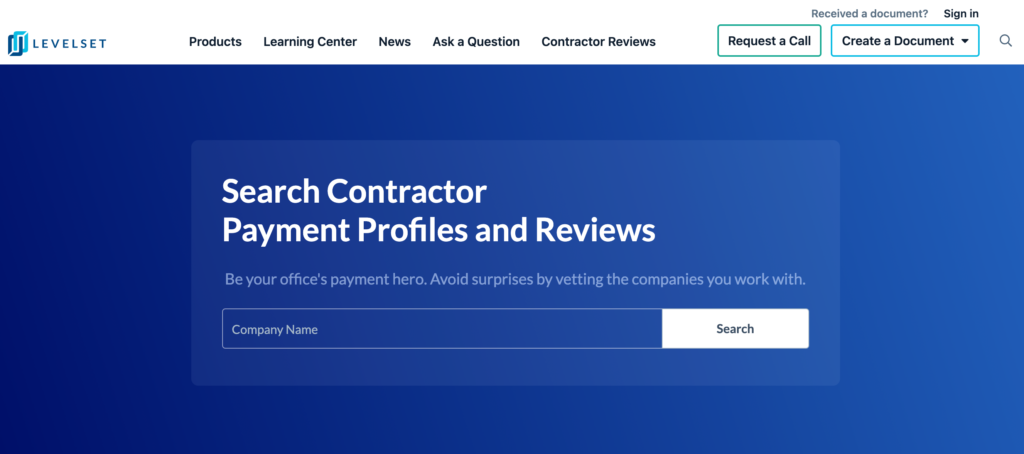
General contractors spend years putting together a crew of subcontractors that they can rely on. Lining up the right subs can take time, but it doesn’t have to. You need to know how to find the best subcontractors in construction right now — and get them working for you.
This guide will help expedite the process. It contains some helpful tips and starting points you can use to suss out your subcontractor situation and get your job off the ground, including how to find a subcontractor, how to prequalify, and what to do during the hiring process.
1. Scope out construction-related websites
One of the best ways to get your name in front of prospective subcontractors is through one of the many construction-related websites available.
Try checking out websites like Associated General Contractors (AGC), your local chapter of the Building Industry Association, Associated Builders and Contractors, or the Procore Construction Network.
Once signed up and ready to go, you’ll want to post a Request for Proposal to pique subs’ interest. Be sure to mention some important details about the project and what you’re looking for so you’re not wasting your time or the time of the subs applying.
2. Scour social media channels
Nearly every business has a social presence these days, and their profiles typically serve as a portfolio of sorts.
Be sure to peruse all the pictures the sub has posted on their social page, and read comments and reviews. Remember, the goal is to hire a professional outfit. If you can spot safety violations or unprofessional behavior in their shots, you already know everything you need to.
The other good news is that most medium to large-sized subcontractors are very easy to reach via social media. You’ll likely hear back quickly, and if you’re not speaking with the appropriate person, they’ll point you in the right direction.
3. Follow word-of-mouth recommendations
If you’re established in the area and know a few folks in the industry, word of mouth can be a surefire method of how to find a great subcontractor. If someone you trust recommends them, the sub must be bringing something valuable to the table.
But, therein lies the rub: You have to trust the person you’re asking, and you need to do some research before you blindly award a contract to a suggested sub. We’ll dig in a little deeper on that in a bit.
Don’t forget to talk to your suppliers. They’re an undervalued source of information in the construction industry. They know every contractor and subcontractor, all the materials they’re buying, and all the projects they’re working on. Chances are they’re familiar with just about every project, past or present, in your area.
Ask them who’s landing the most jobs in drywall, plumbing, flooring, or whichever trades you’re hunting. Be sure to ask the supplier who’s been in hot water with GCs as well. One of the other benefits of this approach is that the supplier isn’t likely to suggest a sub who doesn’t pay them on time, which can cause them to file materialman’s liens against project properties. But we’ll go further into that in a bit.
Even if you can’t find a subcontractor right away, this step will likely net you at least a few good leads —while also building a rapport with your suppliers.
4. Consult their contractor profile
Once you have an idea of how to find a subcontractor that’s best for you, you need to dig deeper. You can’t hire a sub from an Instagram page or one person’s suggestions. You have to prequalify potential subcontractors to find the right fit for the job.
Even with a glowing recommendation or a fancy job portfolio, you can’t just take a subcontractor’s word for anything. Again, you have to dig. And one of the best places to start this excavation is their Contractor Profile.
A Contractor Profile can tell you a lot about what a prospective subcontractor might be like to work with. These profiles contain data about construction companies’ payment practices, dispute history, past liens, and reviews from other businesses who worked on projects with them.

Here’s why this is so important: Recall the situation above about a sub-sub threatening to file a lien for non-payment. Let’s take it a step further and say that the sub-sub actually files a mechanics lien. The lien attaches to the property, and it can cause significant headaches for the property owner. It can slow the entire project down, cause issues securing further financing, and more.
A mechanics lien can even compel the project owner to sell the property so the unpaid contractors can divvy up the proceeds.
If the GC or project owner consulted the Contractor Profile for this subcontractor, there might have been mention about poor money management or underhanded treatment. If that was the case, the hiring party could’ve avoided the entire issue and kept the project free from liens.
5. Consider the size of the crew
When you’re sorting through the host of subcontractors that responded to your RFP or just reviewing the companies suggested to you, you need to consider their size.
If you’re GCing a small addition project, a smaller crew of just a few guys is okay. But if you’re acting as the GC on a large commercial job, your subs need crews large enough to keep up.
6. Get to know their experience
You’ll want to be sure any prospective subcontractor has the experience to complete your project. While it’s okay to hire a newer contractor, you probably don’t want them cutting their teeth on the same project on which you’re cutting yours.
Be sure to ask for references and actually speak to them. Most of the time, those references will be other GCs and subs, but you can also inquire about speaking with project owners for a clearer picture. Also, consider asking for a project portfolio if they have one available.
7. Review their safety records
As a GC, it’s often your neck on the line when things go badly. Inquiring about a subcontractor’s safety record is never a bad idea as repeat violations can cost you.
Medium to large-size subcontractors probably have a file of safety records you can peruse, but don’t be surprised if smaller subcontractors don’t. When that’s the case, you should inquire about their safety history in the interview and ask around to other subcontractors to verify it as best as possible.
8. Make sure to verify license and registration
Before you hire a subcontractor, you need to familiarize yourself with the licensing and registration requirements in your state to ensure they’re on the up and up. Many states require certain subcontractors to carry a license, while others might not. It’s all very relative to the state the project calls home.
Some states levy hefty fines on GCs and homeowners who hire unlicensed contractors as a way to deter unlicensed work. You don’t want to learn that the hard way.
9. Ask for proof of insurance
Be sure to ask any prospective subcontractor for proof of insurance. You’ll want to be sure they meet the general liability requirements in your area (if there are any) as well as workers’ compensation coverage if they have employees. If they don’t have insurance or aren’t able to secure insurance, that alone can say quite a bit about the outfit.
Learn more: The Risks of Not Taking Out Contractor Insurance
10. Review their financials
If you’re working on a larger project, it might be a good idea to ask any subcontractors for financial reports. What you’re looking for is really up to you, but you’re essentially ensuring that the subcontractor is worthy of handling money.
If a sub’s financials or credit history don’t paint them in the greatest light, it can be a sign of issues to come. Picture this: your sub hires its own sub, but because of financial pressures, they hold onto the sub-sub’s payments. After a certain point, the sub-sub will become irritated and start threatening to file liens against your project — not a great position to be in. You’ll either have to ante up with the sub-sub and take it out of the sub’s hide or somehow compel the sub to do the right thing.
11. Conduct interviews
Veteran general contractors might be used to interviewing would-be subs, but newer GCs and homeowners might not be so familiar. There’s more to how to find a subcontractor than seeing the lowest bid and going for it. You need to interview each prospect and get to know them. This can be an important step for weeding out the unprofessional, tardy, and unqualified subs.
12. Master the hiring process
Once you’re happy with the sub, their bid, and their Contractor Profile, it’s time to hire them. Luckily, the process is rather straightforward, and there are two main documents you’ll need to address when hiring a subcontractor: the 1099 and the W9.
Any contractor or person who makes more than $600 in the course of a trade or business and who is not an employee needs to fill out a 1099 form.
While you don’t have to withhold taxes from a subcontractor’s payments, you want to make sure you’re not liable. In those cases, having your subs sign a W9 helps relieve the liability.
The best subcontractors aren’t hard to find if you know how to look for them
Finding great subcontractors might take a little bit of effort, but it’s worth it. With a bit of background investigation and by requesting the right documentation, you’re able to avoid many of the headaches of partnering with a new subcontractor.
Plus, if you consult their Contractor Profile, you’ll have an excellent idea of how a subcontractor operates and possibly even avoid serious delays caused by a mechanics lien.